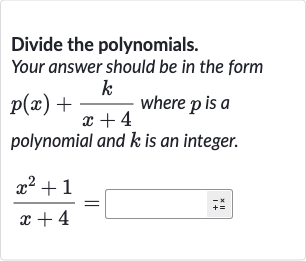Full solution
Q. Divide the polynomials. Your answer should be in the form where is a polynomial and is an integer.
- Set up division: Set up the division of the polynomials in long division format.We will divide the polynomial by using polynomial long division.
- Determine divisor count: Determine how many times the divisor goes into the first term of the dividend . The first term of the divisor goes into the first term of the dividend exactly times because .
- Multiply and subtract: Multiply the entire divisor by the result from Step and subtract it from the dividend . Multiplying by gives us . We subtract this from to find the remainder.
- Bring down next term: Bring down the next term of the dividend, if any, and repeat the process.Since there are no more terms to bring down, we now have a remainder of .
- Write result in form: Write the result in the form where is the quotient and is the remainder.The quotient from our division is and the remainder is . However, we need to express the remainder as a constant over the divisor . To do this, we continue the division process to find the constant term.
- Determine remainder division: Determine how many times the divisor goes into the remainder .The term cannot be divided by to give a polynomial term, so we stop the division here. The remainder is .
- Express remainder as fraction: Express the remainder as a fraction over the divisor .The remainder is , so we write it as .
- Final answer: Since we cannot simplify the remainder further, we have our final answer.The final answer is where and .
More problems from Negative Exponents
QuestionGet tutor help



